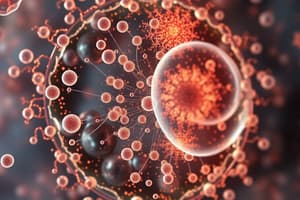Podcast
Questions and Answers
What are ribosomes primarily composed of?
What are ribosomes primarily composed of?
- Chlorophyll and Nucleic Acids
- Carbohydrates and Enzymes
- RNA and Protein (correct)
- DNA and Lipids
Where are ribosomes located within a cell?
Where are ribosomes located within a cell?
- Bound to the endoplasmic reticulum and free-floating in the cytoplasm (correct)
- Only attached to the nucleus
- Exclusively within the mitochondria
- Confined to the plasma membrane
What is the main function of ribosomes?
What is the main function of ribosomes?
- Photosynthesis
- Protein synthesis (correct)
- Energy production
- DNA replication
What process involves the transport of substances out of a cell via vesicles?
What process involves the transport of substances out of a cell via vesicles?
Which of the following best describes receptor-mediated endocytosis?
Which of the following best describes receptor-mediated endocytosis?
Which of the following statements about ribosomes is false?
Which of the following statements about ribosomes is false?
Which organelle is associated with the ribosome and plays a role in synthesizing proteins?
Which organelle is associated with the ribosome and plays a role in synthesizing proteins?
What distinguishes exocytosis from other forms of cellular transport?
What distinguishes exocytosis from other forms of cellular transport?
What is the primary role of the plasma membrane in receptor-mediated endocytosis?
What is the primary role of the plasma membrane in receptor-mediated endocytosis?
In which scenario would exocytosis NOT occur?
In which scenario would exocytosis NOT occur?
What is the primary function of lysosomes?
What is the primary function of lysosomes?
Where are lysosomes produced within the cell?
Where are lysosomes produced within the cell?
What type of enzymes do lysosomes contain?
What type of enzymes do lysosomes contain?
Which of the following best describes the composition of lysosomes?
Which of the following best describes the composition of lysosomes?
What happens to foreign particles that enter the cell?
What happens to foreign particles that enter the cell?
What is the primary product of glycolysis from glucose?
What is the primary product of glycolysis from glucose?
What happens to pyruvate when oxygen is not available?
What happens to pyruvate when oxygen is not available?
How many ATP molecules are produced directly from glycolysis?
How many ATP molecules are produced directly from glycolysis?
What role does oxygen play in mitochondrial metabolism?
What role does oxygen play in mitochondrial metabolism?
What significant effect occurs when mitochondrial metabolism is blocked without oxygen?
What significant effect occurs when mitochondrial metabolism is blocked without oxygen?
What is the primary role of NADH in the electron transport chain?
What is the primary role of NADH in the electron transport chain?
How many ATP molecules are generated during the electron transport chain process?
How many ATP molecules are generated during the electron transport chain process?
In which cellular location does the electron transport chain primarily operate?
In which cellular location does the electron transport chain primarily operate?
Which of the following processes occurs before the electron transport chain?
Which of the following processes occurs before the electron transport chain?
What is the significance of oxygen in the electron transport chain?
What is the significance of oxygen in the electron transport chain?
Flashcards are hidden until you start studying
Study Notes
Receptor-Mediated Endocytosis
- Involves the uptake of specific substances by cells through receptors on the plasma membrane.
- This process helps in selective transportation of molecules, ensuring efficient nutrient uptake.
Exocytosis
- A process where cells expel materials through vesicles that fuse with the plasma membrane.
- Essential for releasing hormones, neurotransmitters, and waste products from the cell.
Structure and Function of Ribosomes
- Composed of RNA and proteins, they are critical organelles for protein synthesis.
- Ribosomes can be found free-floating in the cytoplasm or bound to the endoplasmic reticulum (rough ER).
Endomembrane System
- The endomembrane system includes lysosomes, which are vesicles containing digestive enzymes.
- Lysosomes play a key role in breaking down cellular debris and foreign particles to maintain cell health.
Metabolism and Energy Reactions
- Glycolysis breaks down glucose into pyruvate, yielding 2 ATP without oxygen.
- In the presence of oxygen, pyruvate enters the citric acid cycle and ultimately contributes to the electron transport chain in mitochondria, producing up to 32 ATP.
- Mitochondrial metabolism is inhibited without oxygen, leading to alternative processes like lactic acid or ethanol fermentation.
Studying That Suits You
Use AI to generate personalized quizzes and flashcards to suit your learning preferences.


